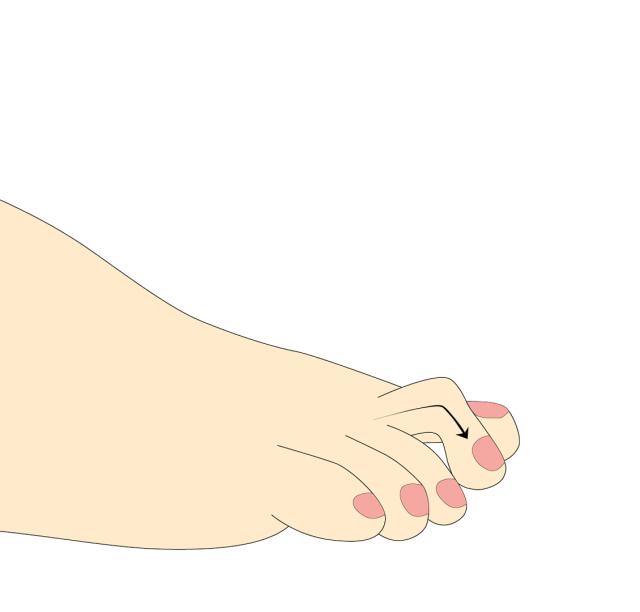What are hammer toes?
A hammer toe is a toe that has been pressed into a hammerhead-like shape. The base joint is overstretched, while either the middle or the outer joint is bent so that part of the toe protrudes upwards. It can affect one toe or several toes. All toes can be affected, but it is rare for the big toe to have this hammer position.
Hammer toes are often seen on feet, where the big toe has begun to turn inwards and you have developed a bunion.
In the beginning, the toes are movable, but if you do not do anything about it, then the toe or toes will stiffen in this hammerhead-like shape.

What causes hammer toes?
As with many other toe deformities, footwear is the biggest culprit. If you walk in too short or narrow shoes for a long time, your toes will bend and eventually the associated muscles and tendons will become shorter and shorter, and eventually the toes cannot stretch out.
It can also be a contributing factor if you have walked for a long time with footwear that does not fit well enough on your foot - then you bend your toes to grip your footwear when you walk.
Many hammer toes are associated with the development of flat feet. This means that the arch of your foot has become smaller and smaller, so that your big toe starts to turn towards the other toes, and the small toes begin to contract. However, there are also diseases that can be the cause of hammer toes. It can be nerve and muscle disorders, but there are also many people with arthritis and/or diabetes who experience that their feet change.
> Read more about about feet and diabetes here
> Read more about feet and arthritis here
Finally, it should be mentioned that hammer toes can also be due to damage to the toes or congenital malformations. The misalignments contribute to the skin on the upper side of the toe rubbing the shoe's upper, which can lead to redness, hard skin, corns or ulcers - and thereby pain. The hammerhead shape also means that you press on your nails when you walk - this can lead to the nail becoming thickened and ingrown.
What can you do to avoid hammer toes?
The most important thing you can do is choose footwear that is long and wide enough, and has room around your toes. Choose footwear that has an effective closing system so that your footwear is firmly attached to your foot.
Sometimes it can also be an excellent idea for your footwear to be made with a soft material over the toes so that there is no pressure.
> Read more about OrthoStretch® here
> Read more about our footwear here
> Read our shoe guide to get good tips and advice about choosing footwear here
Find out if you have misalignments in your foot (such as flat feet) that may aggravate the condition. In many cases, an insole along with the footwear can be what relieves your hammer toes as best as possible. There are both ready-made and custom insoles that are intended to relieve, support, correct or to a certain extent train your feet.
> Read more about our Korrektor® insoles here
It can be an excellent idea to book an appointment with a practitioner - there are many options for having minor relief made in different materials. Together with good footwear and insoles, this can provide extra protection so that you do not have more pain than is absolutely necessary.
Foot exercises
Why should we do foot exercises?
If we are to be able to keep walking the 10,000 recommended steps daily, it is important that we train our feet.
The benefits of training your feet:
- Greater flexibility - If your feet are pliable and flexible, then your whole body can move better - this also gives better balance.
- Prevents injuries - Many problems with the knees, hips and back occur when the foot's suspension and turning function is impaired.
- Better blood circulation - Blood circulation is promoted, and you will find it easier to keep your feet warm and if you have swollen feet, it is really good to do articular pump exercises.
- Wellness - If you want to stay healthy and fit all your life, it is important to have good and mobile feet for as long as possible.
> Find foot exercises on YouTube from the Danish Chiropody and Podiatry Association and choose those that best suit you
Remember that your feet are your body's foundation - they must support you all your life.
If you have been diagnosed with a disease that requires special footwear or insoles, it is important that you listen to your practitioner's advice. Experimenting on your own can have serious consequences. We and our resellers are happy to advise, but it is your practitioner who has access to your medical history and so the practitioner's advice is very important.